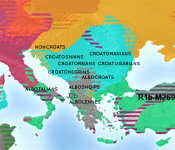It is nonsense. Modern Albanian has (in roughly chronological order) Greek, Latin, East Germanic, Slavic and Turkish loanwords. Proto-Indo-European is conventionally dated to circa 3500 BC, yes, but by no means does that mean that, for example, Greek or Albanian (in their modern forms) are that old, because they clearly aren't.
For Greek, we do have the attestation of Mycenaean Greek (from the Bronze Age), which is very different from modern Greek, and even quite different from the classical Greek of, say, one Homer.
Within Indo-European, Greek and Albanian are indeed not
closely related and as far as their phonetical evolution goes, they have little commonalities: Greek is a Centum language (the "palato-velar" sounds of PIE are merged with the "plain" velars), while Albanian is a Satem language (the "palato-velars" are expressed as fricatives - in the case of Albanian mainly *θ and *ð). Further, Albanian has Proto-Indo-European
*o shifted to
*a (a commonality it has with Germanic and Balto-Slavic). In contrast, Greek has shifted word-initial *s- to *h- (a commonality it has with Armenian and the Iranic languages).
About loanwords in Albanian, I'd like to pick Latin ones for a demonstration, since they make up a large part of the
Albanian vocabulary:
mik (friend - 'amicus')
qen (dog - 'canis')
qytet (town/city - 'civitas')
peshk (fish - 'pisces')
pulë ('chicken' - pullus)
shok (friend - 'socius')
If Albanian borrowed all these words from Latin, and they are subject to subsequent phonetic evolution, by what logic is Albanian "5000 years old" if the language was a very different one 2000 years ago?
About E-V13, as you know it has been found in one of the
Neolithic sites from Spain, suggesting it was once widespread in Europe in the Neolithic, considerably older than PIE.






